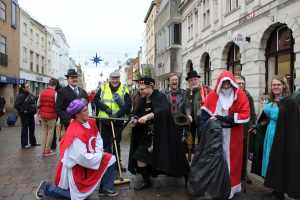Can cure the hitch, the stitch, the palsy and the gout.
All pains within and all pains out;
If the devil’s in this man, I’ll fetch him out…
Mummers’ Plays are traditionally performed over the Christmas period and are believed to have their roots in pre-Christian rituals. They are almost certainly older than Morris Dancing.
Central to all Mummers’ plays is the battle between light (personified by St George or King George) and darkness (personified by the Turkish Knight). The two fight and St George kills the Turkish Knight, significantly when the darkness is at its strongest. The quack doctor then “mysteriously” revives the Turkish Knight so the fight may continue the following year. Once this is complete various sundry characters follow who have little to do with the story line, and are later additions provided to encourage the audience to part with their money.
Every Village in England would have had its own Mummers’ Play at one time. There are believed to be about 1,000 extant plays which fall into three categories: Combat Plays, Wooing Plays, confined to Rutland, Lincolnshire, Nottinghamshire & Leicestershire, which are normally sung or have an element of song in them, and Sword Plays originating from the North of England.
Lassington Oak Mummers perform the play from Highnam. The play was last performed in either November 1901, 1904 or 1918 by the Highnam Mummers, before being revived and performed by us for the first time on Wednesday, 18th December 1996 at The Dog, Over; The Tall Ship, Gloucester; The Whitesmiths Arms, Gloucester and The Fountain Inn, Gloucester.
The Blacking of the faces is traditional. It is believed it may have ritualistic origins, although it is more likely that it formed a form of disguise to assist begging, which in the past was heavily punished.
Lassington Oak Mummers would like to stress that they only beg for charity, not beer (although we will accept gifts of beer readily).

